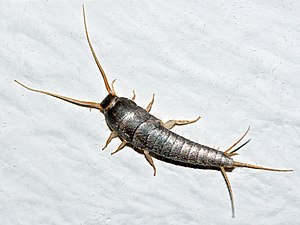Silverfish
| Silverfish | ||||||||||||
|---|---|---|---|---|---|---|---|---|---|---|---|---|

Silverfish ( Lepisma saccharina ) |
||||||||||||
| Systematics | ||||||||||||
|
||||||||||||
| Scientific name | ||||||||||||
| Lepisma saccharina | ||||||||||||
| Linnaeus , 1758 |
The silverfish ( Lepisma saccharina ) is a nimble, light-shy and wingless insect that got its name from its silver-gray, streamlined body. The scientific name and designation sugar guest go back to the preference for carbohydrates such as sugar or starch .
It belongs to the order of fish (zygentoma), which has probably existed for 300 million years.
Appearance
The body length without attachments is about one centimeter. The antennae are long and threadlike, and the feet have two, three or four limbs. The metallic luster is caused by the covering with silvery scales that appear after the third molt . The animals have two front tactile sensors and three tail appendages ( cerci and epiproct ) at the end of the abdomen , which also represent touch-sensitive sensory organs .
habitat
Silverfish love warmth and, like the paper fish ( Ctenolepisma longicaudata ), the furnace fish ( Thermobia domestica ) and the ghost fish ( Ctenolepisma calva ), occur particularly in human dwellings. They are nocturnal and extremely photophobic. During the day, the animals hide in dark cracks and joints, behind skirting boards and rubbing strips and loose wallpaper . In addition to warmth, silverfish prefer higher humidity; they are often found in kitchens, bathrooms and laundry rooms. Optimal conditions are 20 to 30 ° C and 80 to 90% relative humidity. They can be found under refrigerators and in well-heated toilet rooms if the floor tiles have cracks and crevices.
Reproduction and development
The insects open the mating ritual in the dark with a dance by the male; then males and females run around excitedly. Finally, the male lays a sperm bag ( spermatophore ) under a self-spun web on the floor. The female ingests it (indirect sperm transfer) and uses it to fertilize the eggs. Silverfish develop without metamorphosis and reproduce until they die.
The silverfish needs at least four months, sometimes up to three years, to grow up, depending on the living conditions. At room temperature it develops into a full-grown insect within a year, which can reach an age of up to eight years. A sexually mature silverfish has molted about eight times . Even after that, up to four moults per year take place because the animal continues to grow. The female lays around twenty eggs, preferably in crevices and crevices, when the temperature there is between 25 and 30 degrees Celsius. In cold and dry conditions, no reproduction is possible.
Food and predators
Silverfish look for their food in the dark and prefer starchy substances or dextrin in adhesives: paste , book covers, photos, sugar, hair, dander and house dust mites . But they also do not disdain cotton , linen , silk , mold , paper and synthetic fibers , just as little as dead insects or their own exuvia (stripped skin). Silverfish belong to the few animal groups that have their own cellulases , i.e. they do not depend on endosymbionts to digest cellulose . You can go hungry for several months without being harmed.
The common earwig ( Forficula auricularia ) is known as the predator of the silverfish . Spiders are also considered predators of the species in the domestic sphere .
Beneficial or pest?
Silverfish that appear sporadically in the bathroom or kitchen are harmless. An extreme infestation can indicate a moisture problem and mold infestation. The silverfish are just a warning sign here. They even mitigate mold growth because they feed on these fungi. They also eat dust mites, which can cause allergies in humans. Therefore, they are also to be regarded as beneficial insects. They are not carriers of disease; control is not necessary from a hygienic point of view.
Due to their cockroach and pitting corrosion, silverfish can damage leather goods and synthetic fiber fabrics, but also damage books and contribute to paper disintegration.
Silverfish and law
The Hamm Court decided in 2017 that if in a sold condominium are to be found silverfish to a small extent, this does not purchase contractual defect i. S. d. § 434 Paragraph 1 Sentence 2 BGB justified. A certain number of animals is common and since there is no health risk, this does not run counter to the contractual residential purposes. In the specific case, the animals multiplied explosively after the apartment was handed over. This development was due to the fact that the entire apartment was painted by the buyer and the associated rise in humidity in buildings with older structures. The legally relevant point in time, however, is the condition when the purchased item is handed over when the risk passes .
Web links
- Fauna Europaea - Lepisma saccharina Linnaeus
- Carsten Pusch: The prehistoric cattle in the bathtub. schleswig-holstein.nabu.de
Individual evidence
- ↑ R. Wehner: Zoology. 24th edition Thieme, Stuttgart 2007, chap. 4, p. 327.
- ↑ Anneliese Penzendorfer: Animals that hibernate in our house: pests or beneficials? In: Vorarlberg online. February 19, 2009, accessed July 14, 2013 .
- ↑ Wibke Unger and Katrin Schöne: SiLK - Security Guide for Cultural Assets, 10. Pests / mold, which insects attack which materials? Conference of National Cultural Institutions, accessed March 18, 2020 .
- ↑ OLG Hamm, judgment of June 12, 2017, Az. 22 U 64/16, full text .


